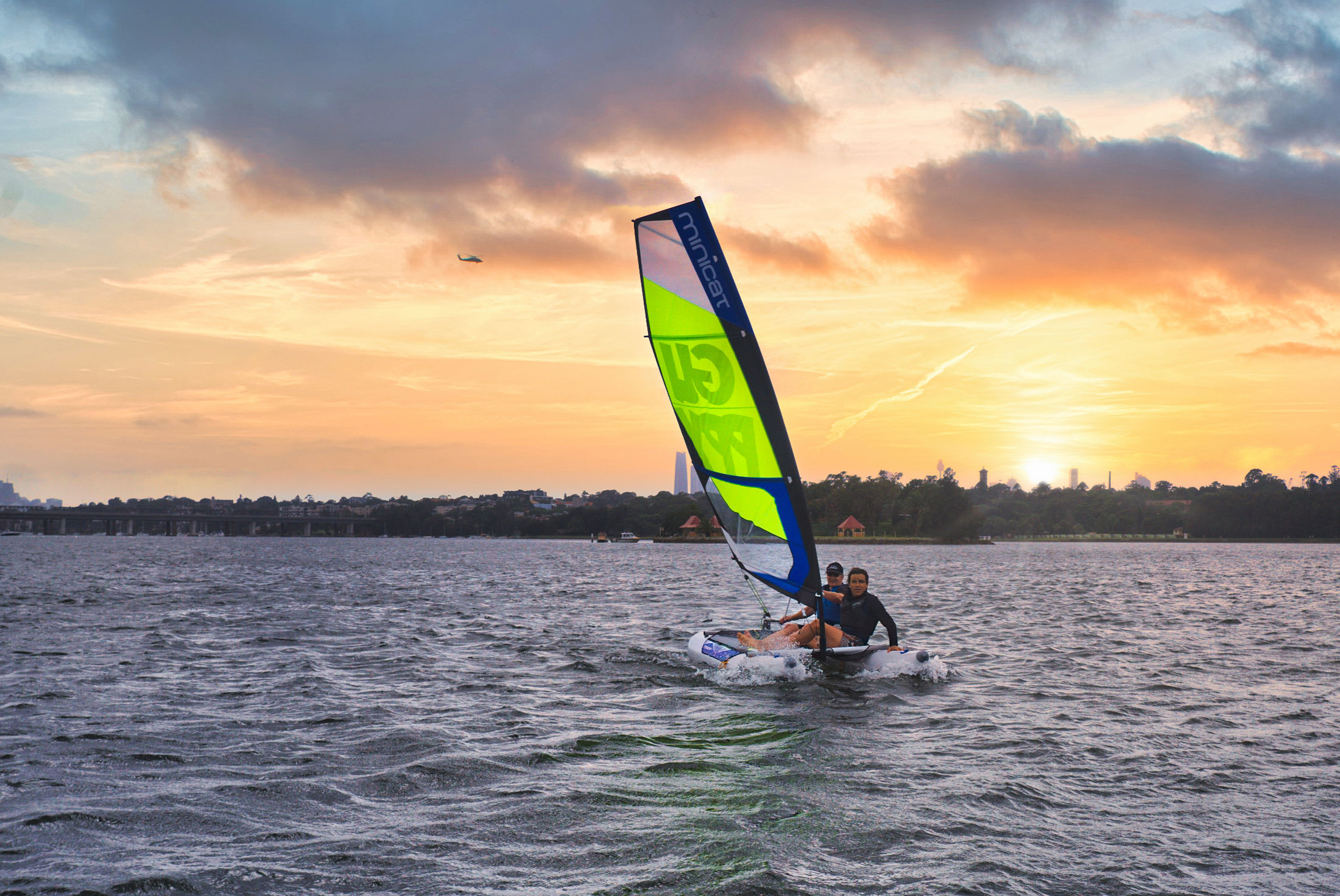
F U N & V E R Y S I M P L E C O N T R O L
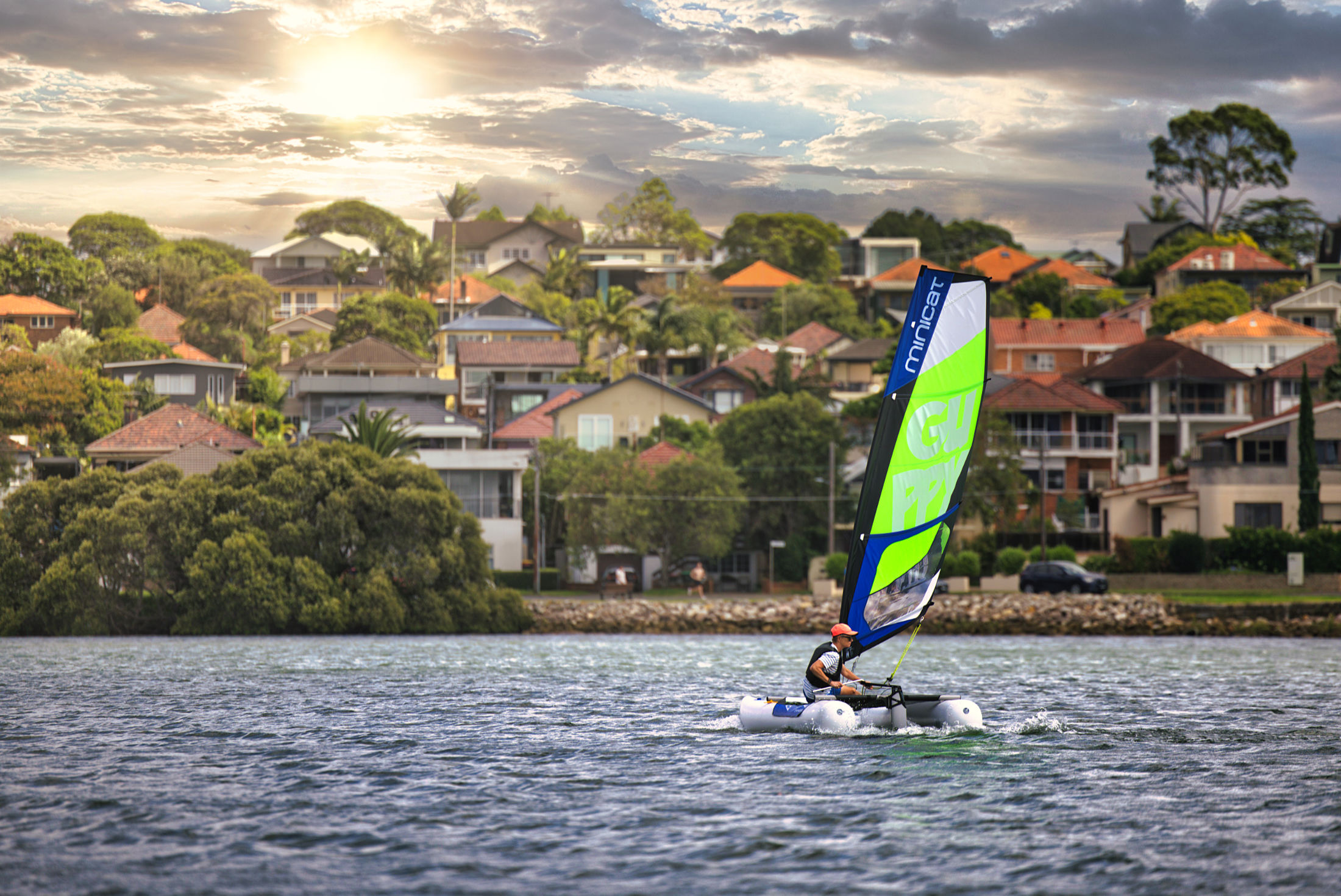
S U P E R S A I L I N G E X P E R I E N C E
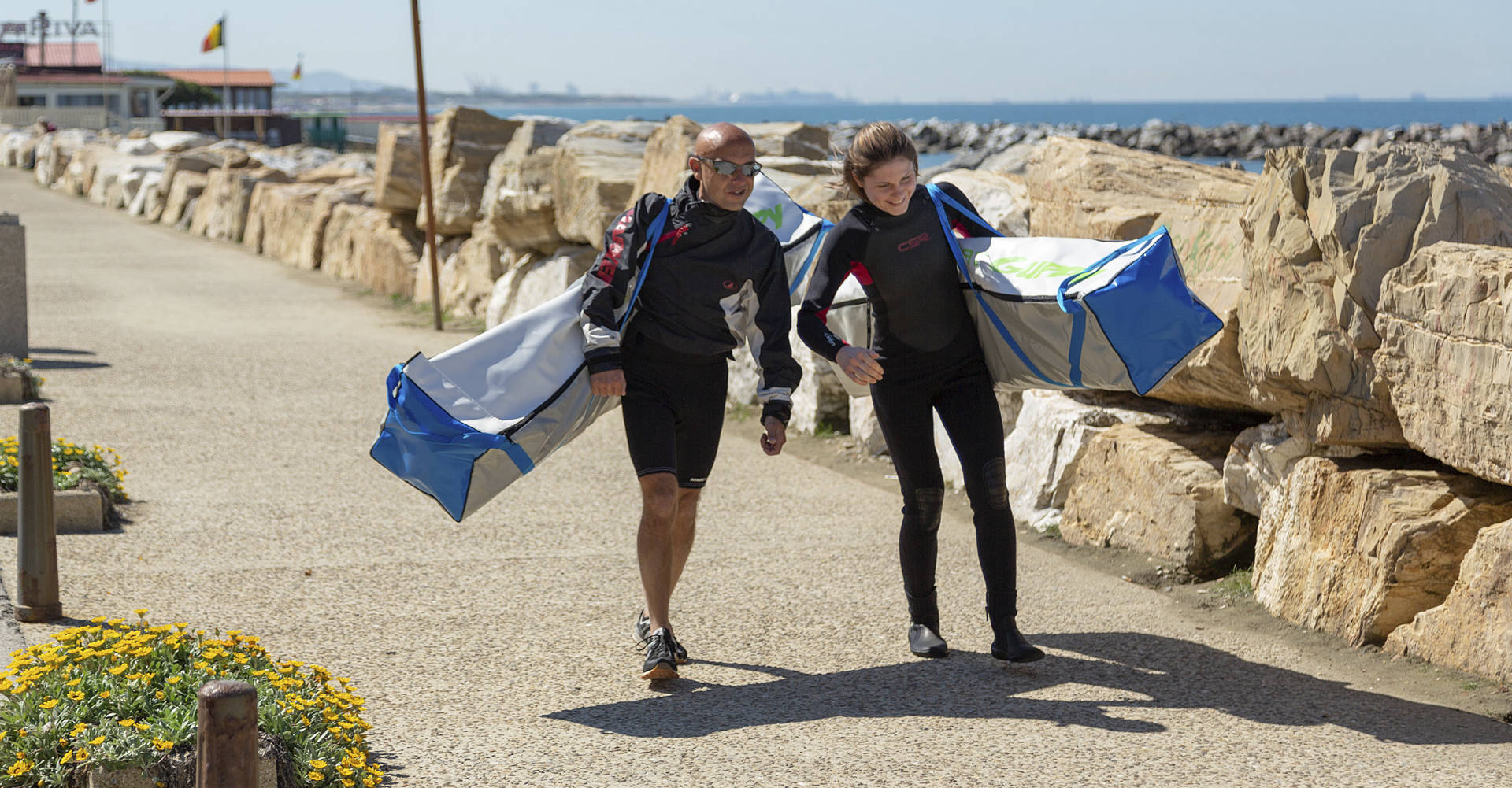
F L E X I B L E & E A S Y T O T R A N S P O R T
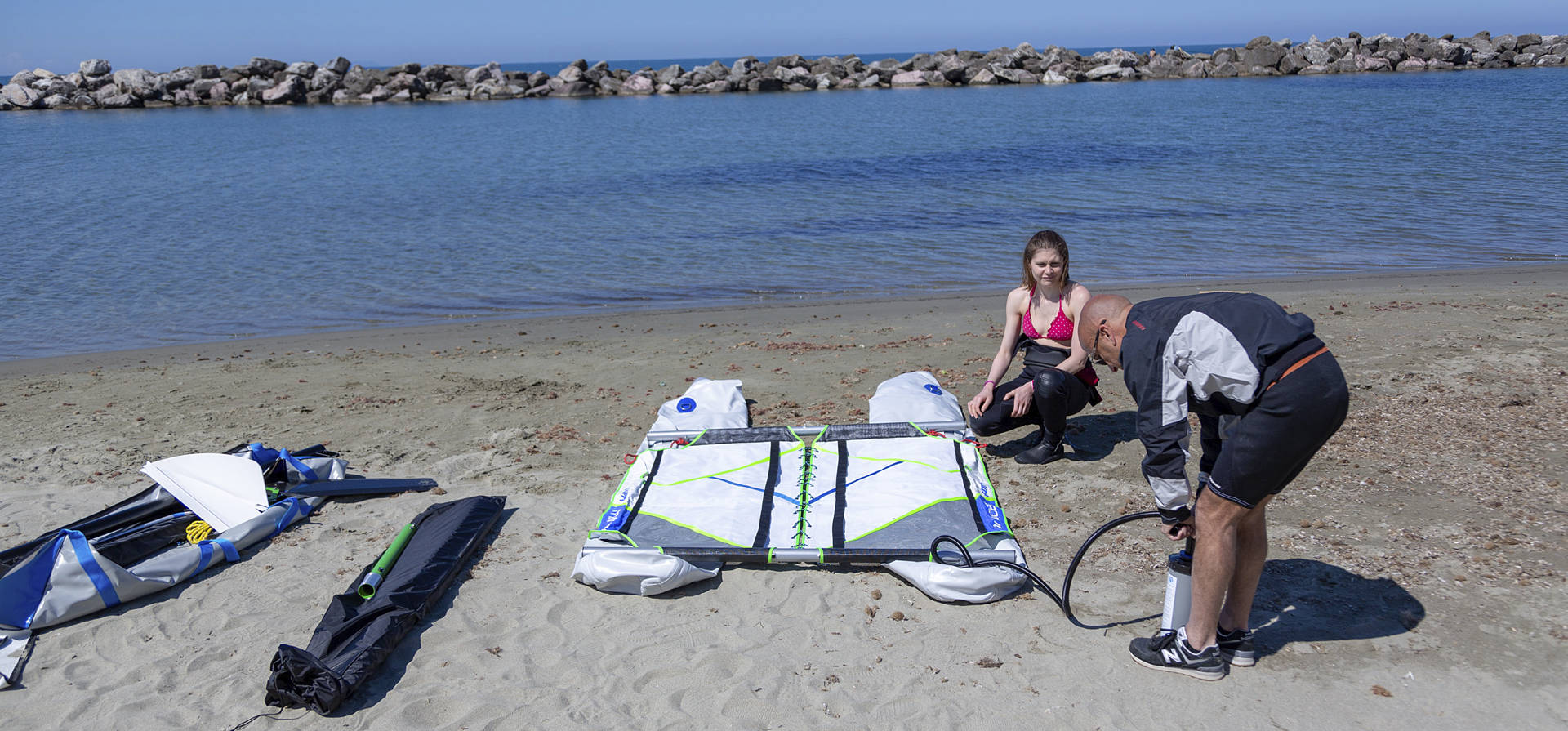
P O R T A B L E & F A S T T O A S S E M B L E
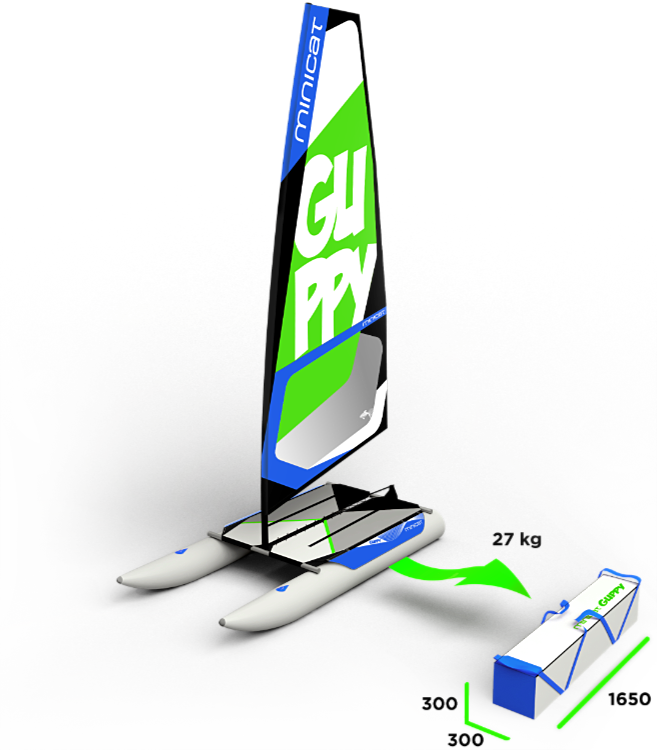

THE WORLD'S FAVORITE PORTABLE SAILBOAT
Searching for a light portable sailboat that is no hassle to transport, fast to assemble, easy to handle, looks great and you can afford it? A boat that doesn’t need a trailer, takes minimum storage and is perfect for apartment living, campers & lovers of the outdoors, travelling sailors and as yacht toy?
Search no more – you found it! It’s called GUPPY and it’s just few clicks away.
GUPPY is an inflatable catamaran you can take on the plane with you when going on a sailing holidays, is easy to fit in any campervan, motorhome or RV, even a family car and is a great addition to your super-yacht or live-aboard without the usual storage and assembly problems.
- 3-piece flexible composite mast
- No anchoring lines
- Main Sail 4.5 m2 / no Jib
- Aluminium Rudder
- Grey Floats pre-fixed to the main frame
- Super easy and fast assembly – 10 mins only – no tools required
- Fits in a single bag 165x30x30cm and only 27 kg
- Colourful and trendy design
- 24-month full product warrant
- Accessories available
- Produced by long-established portable sailboat brand ‘MiniCat’
Based on our 17 years of experience in designing and producing MiniCat – the world’s favorite portable sailboat, we set out to create an all-new ‘entry model’. We took over a year of design, development, testing, changing and testing again but we are now proud to introduce you the all-new addition to MiniCat family - ‘GUPPY’.
With an assembly time of just 10 mins this sailboat is a fantastic addition to the current MiniCat range especially for those who are looking for a fun, easy and affordable first sailboat.
Based on our 14 years of experience in designing and producing MiniCat – the world’s favorite portable sailboat, we set out to create an all-new ‘entry model’. We took over a year of design, development, testing, changing and testing again but we are now proud to introduce you the all-new addition to MiniCat family - ‘GUPPY’.

Because it is so simple! From being stored in your cupboard or garage just load it in the car and go. One bag weighing just 27kg, assembled in 10 mins – that’s GUPPY, the unique portable sailboat.
Want to take your own small sailing catamaran on holidays? Want to have some fun sailing at the weekend, but don’t have space for your own boat?
The solution is GUPPY!
Because it is so simple! From being stored in your cupboard or garage just load it in the car and go. One bag weighing just 26kg, assembled in 15 mins – that’s GUPPY, the unique portable sailboat.
BUY YOUR GUPPY NOW FOR JUST €3,450 (excl. VAT)
Buy your guppy now for just €3,450 (excl. vat).
- Technical data
- Assembly video
- Assembly manual
- Accessories
- Storage solution
- Transport solution
- Guppy for campers
- Guppy for yachts
- Laura Dekker
- Testimonials

How To Sail a Small Catamaran (Complete Guide)
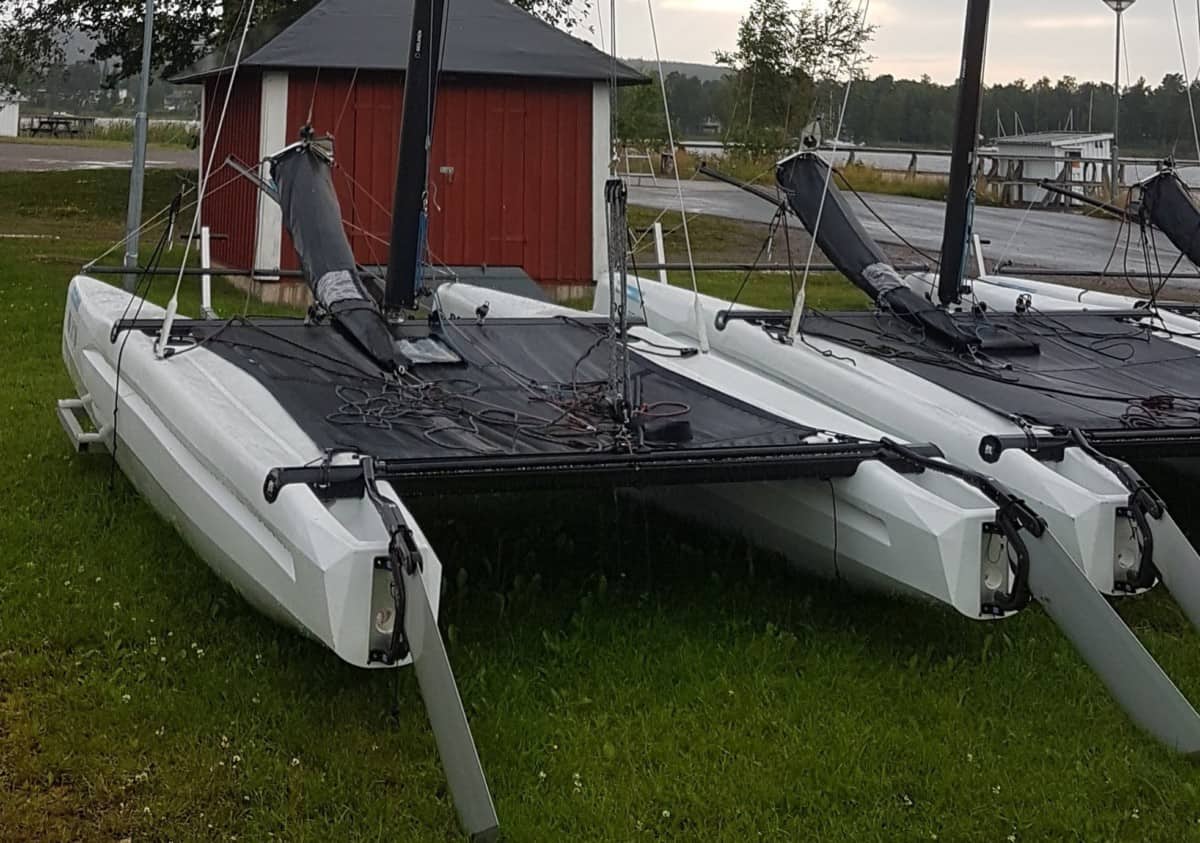
As an Amazon Associate, we earn from qualifying purchases. We may also earn commissions if you purchase products from other retailers after clicking on a link from our site.
Learning how to sail a small catamaran(also known as beach cats) can be the beginning of a new and exciting chapter in your life. It gives you the freedom to comfortably explore the waters, which offers a stimulating and relaxing sensation. If you’re interested in learning how to sail, it is advisable to start with a small catamaran.
To sail a small catamaran (beach cat), first, familiarize yourself with the catamaran’s essential parts and common sailing terminologies. Understand how it works and equip yourself with the necessary sailing gear. Additionally, you’ll need to understand the points of sail, how to steer, turn, and stop the cat.
This guide outlines what you need to know about sailing a small catamaran. Read on to learn more on:
- What is a catamaran?
- Understanding how a catamaran works
- Getting equipped
- Sailing basics
Looking to buy a small catamaran? Read my article Best Catamarans For Beginners
Table of Contents
Understanding a Catamaran
The first step in learning how to sail a small catamaran is to understand its essentials. We begin by looking at what a catamaran is, its essential features, and some standard sailing terms. Understanding the necessary parts of a cat and sailing terminologies helps with communication when sailing.
What Is a Catamaran?
A catamaran is a famous multi-hulled water vessel that features two parallel hulls and sails. Catamarans vary in size and shape, depending on the model and design. However, here we’re looking at the small catamarans (a.k.a. beach catamarans) and how to sail them.
Parts of a Small Catamaran
Below are the essential parts of a catamaran regardless of its model or design:
- Hull : It is the main body of the cat. It has a symmetrical shape, which reduces the drag caused by water friction.
- Tiller : It is a handle or bar that turns the catamaran’s rudder.
- Rudder : An underwater vertical moving board often turned using a tiller (or steering wheel) to initiate movement.
- Keel : It is a centreline attached below the hull running from the front (bow) to your cat’s back (stern). The keel offers stability to the cat and reduces the chances of it capsizing.
- Mast : A long pole set upright from the center of the boat to support the sails.
- Mainsail : It is the most critical sail on a cat that is attached to the mast.
- Foresail : Also known as the jib. It is a sail that fits into the foretriangle of the mast.
- Boom: This is a horizontal pole attached to the mast used for extending the foot of the mainsail.
A full interactive guide on catamaran parts explained ?
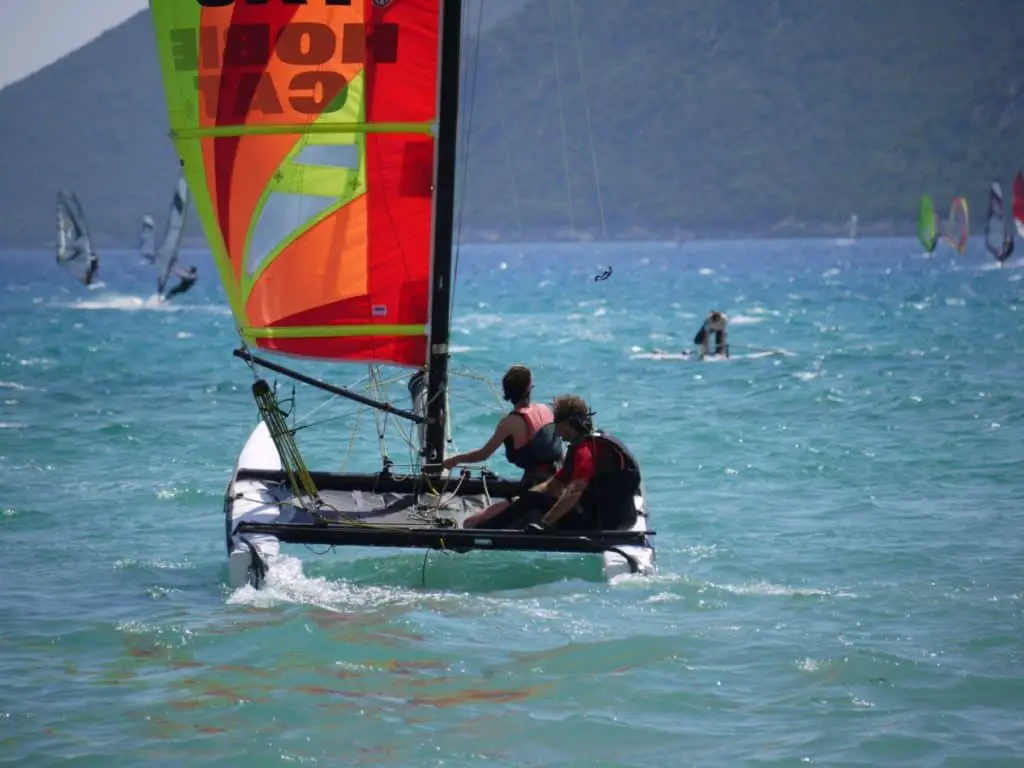
Common Sailing Terminologies
Now let’s look at some terms to add to your sailing vocabulary.
- Point of sail : The direction of your cat relative to the wind.
- Port : When facing forward, your cat’s left side is referred to as the port.
- Starboard : Refers to anything to the right of your cat when you are facing forward.
- Bow/ stern : The front and back of the catamaran, respectively. Additionally, you can refer to the bow as ‘forward’ and the stern as ‘abaft/ aft.’
- Tack: Changing the direction of your cat by turning the bow through the wind.
- Jib (gybe): Turning the stern of your cat through the wind to change direction.
- Heeling: A situation where the wind pushes your cat as it leans over in the water.
- Windward: The side of your catamaran that is closest to the wind. It can also be defined as the direction upwind from the point of reference.
- Leeward: The side of your cat far away from the wind. It is the direction of a cat upwind from the point of reference.
- Aboard: On or within the catamaran
- Halyards : Ropes used in raising or lowering the sails on the mast.
- Sheets: Are ropes that control the angle of the sails relative to the wind’s direction.
- Tacking vs Jibing Explained
Learning How a Small Catamaran Works
After gaining knowledge of parts of a cat and the common sailing terms, the next step is to understand how the catamaran works. Here, we’ll look at how the wind gets your catamaran moving.
As the sail of your small catamaran fills with wind, it forms an airfoil that propels your cat. Your sails play the most significant role in keeping your cat moving. As a result, you have to pay much attention to their positioning relative to the wind.
You start by raising the sails using the halyards. The mainsail (the sail closest to the stern) should be raised first, followed by the jib (the sail closer to the bow). With your sails raised, you should then trim them relative to the direction of the wind. By trimming your sails, you position them at an angle where they capture more wind.
As a newbie, you should first learn raising and trimming the mainsail before the jib because you will use it more when sailing your small catamaran.
However, you should note that you don’t rely solely on the sails and the wind to get your catamaran moving. You should also use the tiller to move and control the rudder. This way, you will be in a position to angle your cat in your preferred direction.
As you continue sailing, the wind’s direction keeps on changing. As a result, you should use sheets to trim your sails while tacking and jibing with respect to the wind’s direction changes.
Getting Equipped
After learning how a catamaran works, you are a step closer to practicing in the waters. However, before this, you need to prepare yourself by getting the right sailing gear. Your instructor should advise you on the right clothes and safety equipment.
Here are some items you should not leave behind:
- Shoes : You’ll need a pair of fitting shoes that you can comfortably use on the deck. They should be grippy and non-marking.
- Gloves : It is also advisable to have quality sailing gloves. They should be comfortable to wear and also allow you to control the tiller and perform other duties on board. Consider getting heavy-duty and breathable gloves.
- Sunglasses: You’ll also need good polarized sunglasses that will protect your eyes from the glare. When learning how to sail, it is essential to see how the water is moving. This helps in learning how to read the wind.
- Windbreaker : Do not forget a piece of clothing that will keep you comfortable even under windy conditions. It should be warm and waterproof.
- Logbook: You’ll also need a book where you can keep all your sailing records. You can indicate how many sailing classes you’ve taken, the number of hours you’ve sailed, and the waters, shallow or deep.
- Compass / GPS : Don’t leave behind a compass and a map. These come in handy when you want to find a bearing or are lost in the sea.
- First aid kit : When packing your essentials, don’t leave behind a first aid kit. As a newbie, you might have sea sickness during your first sailing sessions. Carry a kit with the right prescriptions.
- Finally, do not leave behind a phone and a power bank, plus enough food and water.
After preparing yourself for sailing, you should also prepare your small catamaran.
Preparing the Catamaran
Preparing your beach catamaran for sailing involves analyzing its parts and studying the prevailing weather conditions.
Perform a Physical Check
First up, conduct a detailed physical check to see if all the parts are in their stable working conditions:
- Check if the tiller is moving freely to control the rudder.
- Look at the condition of your sails. Ensure they are straight and with no holes or frayed edges.
- The rigging should be in their perfect working conditions. Check the standing rigging (everything that keeps the mast and sails upright) and the running rigging (the lines used to raise and control the sails).
- Check all lines . They should be free. This means they should not be wrapped against each other or around any objects aboard. Here you may also need to tie line knots if you intend to use them during your sail.
Study the Wind
Before getting into the waters, you’ve to study the direction of the wind. Knowing how the wind is blowing helps in the proper positioning of the sails and the cat. You can check the wind’s direction by looking at wind instruments in your small catamaran.
Most catamarans have wind indicators strategically placed on their mast. You can use this. Additionally, you can tie small flags on the sides of your cat to help with the direction. Knowing where the wind is coming from allows you to position your cat at the right point of sail.
Points of Sail
The point of sail defines the direction of the wind relative to your cat. With the right point of sail, you will be in a position to sail your catamaran smoothly. The point of sail differs depending on the angle of your cat from the wind. The different points of sail include:
- Running : In a running point of sail, the wind blows behind your back. It is not advisable to use this point of sail as accidents are prone to occur if the wind’s force pushes over your small cat.
- Broad reach : The wind is partially at your back and your side (aft quarter).
- Close reach : Here, you are sailing at approximately 60-75 off the wind.
- Beam reach : You position your cat at an angle of 90 of the wind. It is considered the most precise sailing position.
- Close haul : At this point of sail, you are approximately 45-60 off the wind.
Hoisting the Sails
Now that you have already identified the wind’s direction and positioned your cat, the next important thing is hoisting the sails. While hoisting your sails, it is advisable to start with the mainsail.
- To start with, secure the bottom front of the mainsail to the respective shackles on the boom.
- Notice a small line known as an outhaul that attaches the clew (the lower back part of the mainsail) to the boom. Carefully pull it out until the mainsail forms a smooth airfoil allowing wind to blow over it.
- Now pull down the halyard until it stops . You will notice some flapping on the mainsail, which is normal.
- Ensure that the mainsail’s edges are smooth , then attach the halyard on the winch or cleat.
- Now shift to the jib and hoist it . Start by securing its bottom front part to the boom and then follow a process similar to that of hoisting the mainsail.

Start Sailing
As a newbie, you need to ensure you are on a safe sailing point during your practice sessions. Avoid going far into the waters with your small catamaran during your first training sessions.
Also, ensure that you have enough space around you for your catamaran to turn in response to the wind movements. This is to avoid being thrown back into the dock or in the sand by the moving wind.
As you start sailing, you’ll notice the effects of the wind on your cat. As a result, you may need to make a turn through tacking or jibing .
When sailing, always make sure you place yourself at the right point in your catamaran. Sit at the side where the wind is blowing to; the wind should blow from your back. This means you should be on the opposite side of the sail and not beneath it. Sitting on the wrong side might cause your cat to flip over.
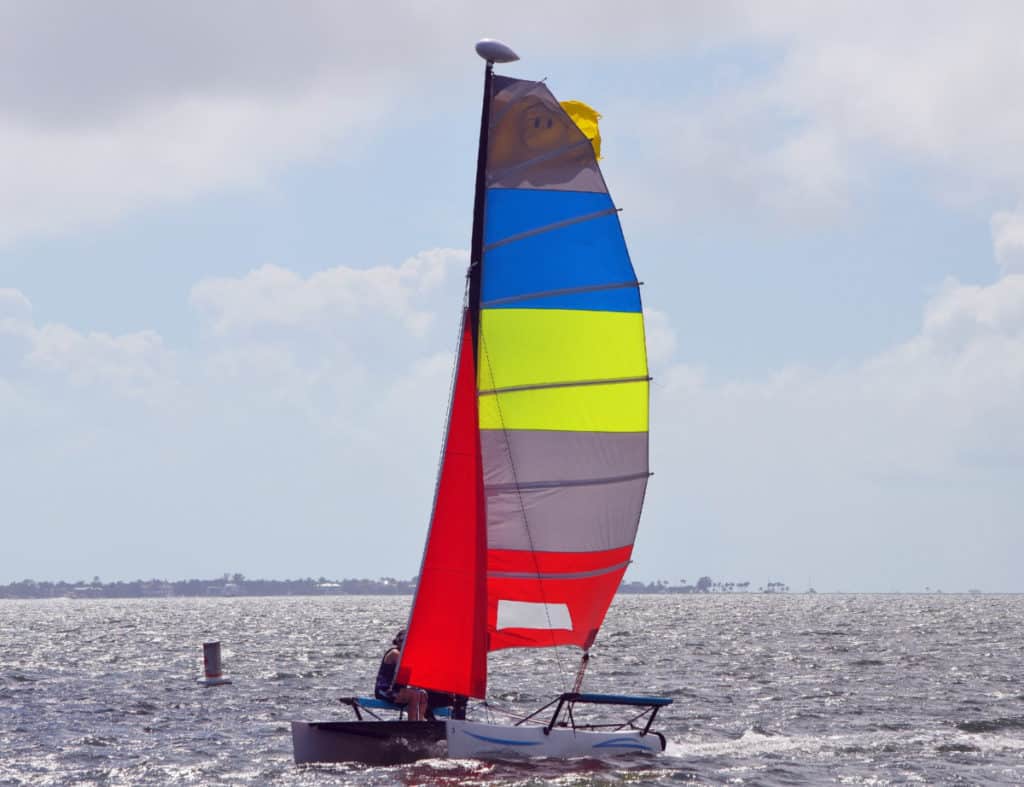
Now that you already know how to get your cat moving, let’s look at steering. Steering the cat is often unclear to most newbies.
Small catamarans are steered using a tiller that controls the rudder. What confuses most sailors is that you move the tiller in the opposite direction from which you want your cat to move. So, if you’re going to turn to the right, you will push your tiller to the left and vice versa.
Since steering a small cat differs from steering other moving vessels, the experience may feel awkward at first. However, you shouldn’t feel pressured to master it all at once. Take your time and practice until you master the process.
Trimming the Sails
As you continue learning how to sail, you also need to understand how to control your cat by trimming sails. Trimming sails means adjusting the positioning of your sails to control the movement of your cat.
As a learner, to effectively and safely trim your sails, you should first position your tiller to reduce the movement of your cat to either side. Start by trimming the mainsail.
Tighten the mainsail to stop flapping and for it to take a new shape relative to the wind’s direction. As your mainsail takes a new form, your cat will start building some speed. Quickly grab the jib and adjust it too.
To tighten the jib, stretch it as much as you can to reduce flapping/ luffing. Once the flapping has reduced, loosen it and let it out until the edge of its luff (the forward end of the jib) is shaking. Now tighten it back in its new position, and you are ready to go.
If you are sailing close to the wind, you have to keep your sails tighter than usual. On the other hand, if you are sailing off the wind, your sail should be left loose. Generally, tight sails cause your cat to move faster, while the opposite is true for loose sails.
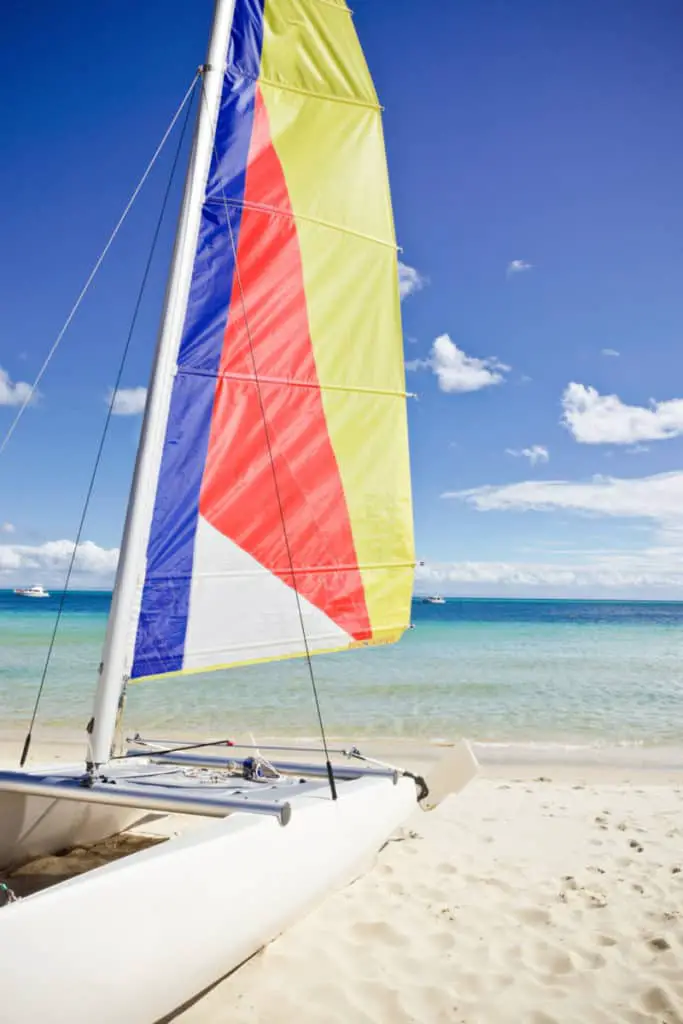
Turning the Catamaran
You’ll also need to learn how to turn a catamaran. As a learner, after releasing the mooring line, you should be prepared to turn the catamaran by moving the boom to either side. As you push out the boom, the wind will hit your sail from the back, making your cat turn.
Therefore, you should be cautious enough to avoid turning in the wrong direction. Like in moving the tiller, you also push out the boom into the opposite direction you want to turn. Therefore, when turning to the right, you push out the boom to the left and vice versa.
Slowing Down and Stopping
Although sailing a small catamaran at high speeds is fun, you may at some point want to slow down. When you detect an obstacle in the water, you may need to slow down. Most sailors use the term ‘spill wind’ to refer to the action of slowing down and stopping a cat.
Since tighter sails often accelerate the speed of your cat, you can slow it down by loosening them a little. The more you let your sails out, the more your cat slows down and eventually stops.
It is advisable to release the sails as you face the wind’s direction to help your cat stop. If you are sailing against the wind, first turn your cat in the direction of the wind, then release the sails.
Practice slowing down and stopping your cat under different weather conditions to be prepared in case of an emergency. Since your cat has no brakes, you should practice this until you perfect your skills.
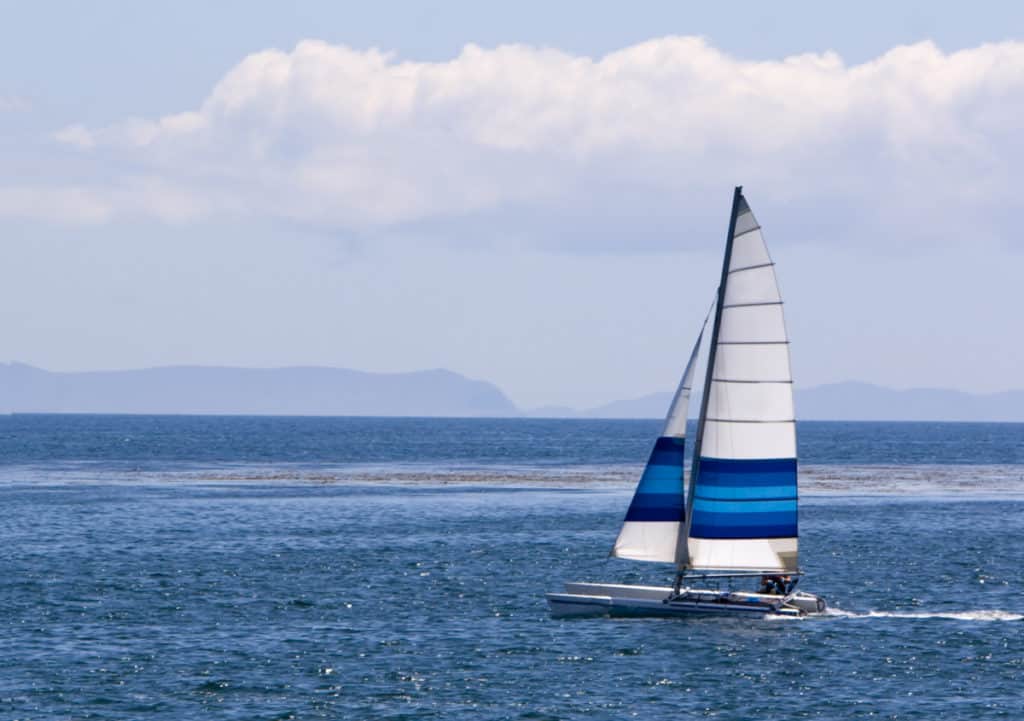
Capsize Recovery
Although capsizing is not common in catamarans, it can happen and it is crucial always to be prepared. If your small catamaran capsizes, it is advisable to start the recovery process immediately before the situation worsens. Let’s look at how to right a capsized catamaran.
Why and how often do catamarans capsize, a scientific approach!
You can right most small catamarans by pushing the bow or stern below the water to rotate them upright.
To right your capsized catamaran:
- Lower down your bow and stern until your cat lies in a vertical position.
- One crew member should then swim around to one end of the lower hull and then push it down. By pushing the lower end down, the uppermost hull’s end comes down towards the water.
- As the uppermost hull drops towards the water, it is pulled down by another crew member. In the meantime, the other crew pushes the cat up midway along the lower hull.
- This movement puts your cat in a vertical position in the water. The crew members then swim to the mast and push it back to its standard sailing position. They then climb aboard fast before the cat sails off.
Avoid sailing alone. Always have some crew members to help you out in case of a capsize.
Learning how to sail a small catamaran is a process that requires practice and patience to perfect your skills. Therefore, don’t feel pressured; take it slow, a step at a time. Start by understanding the essentials of a catamaran, preparing yourself and your cat for the adventure, and learning some sailing basics.
The fundamental sailing basics outlined in this guide are the points of sail, steering, trimming sails, slowing down, and righting a cat after a capsize. Follow our guide today and become a pro in sailing a small catamaran.
- Catamaran Parts Explained
- Why do catamarans capsize?
Owner of CatamaranFreedom.com. A minimalist that has lived in a caravan in Sweden, 35ft Monohull in the Bahamas, and right now in his self-built Van. He just started the next adventure, to circumnavigate the world on a Catamaran!
Leave a Reply Cancel reply
Your email address will not be published. Required fields are marked *
Save my name and email in this browser for the next time I comment.
Recent Posts
Must-Have Boat Gear for Catamaran Sailors!
Sailing is probably the most gear-intensive activity I've ever done; there are so many decisions to be made about what gear to buy now, for tomorrow, and what to definitely never buy. The gear on...
6 Best Trailerable Trimarans For Bluewater and Coastal Sailing
Having a boat costs a lot of money, even when you are not using it, marina fees, etc. And once it is in the water most sailors never go very far from their "home marina" and sailing will be somewhat...

Tasman C43 Just Listed
Used yachts for sale, sail catamarans 40ft > 50ft, tasman boats for sale, tasman c43 boats for sale.
Buy with Confidence
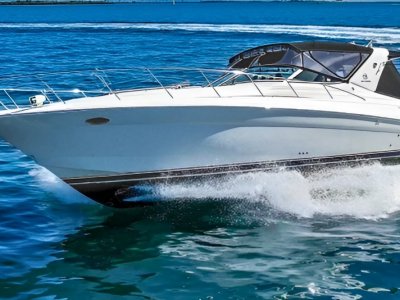
- Storage Solution
- Transport Solution
- Minicat for Campers
- Minicat for Yachts
- Minicat Factory
- Minicat Events
- Laura Dekker
- Laura Dekker’s Foundation
- Testimonials
- Minicat Guppy
- Minicat 310
- Minicat 420
- Minicat 460
- Minicat as a tender
- Parts & accessories
- Used boats for sale
- Distributor map
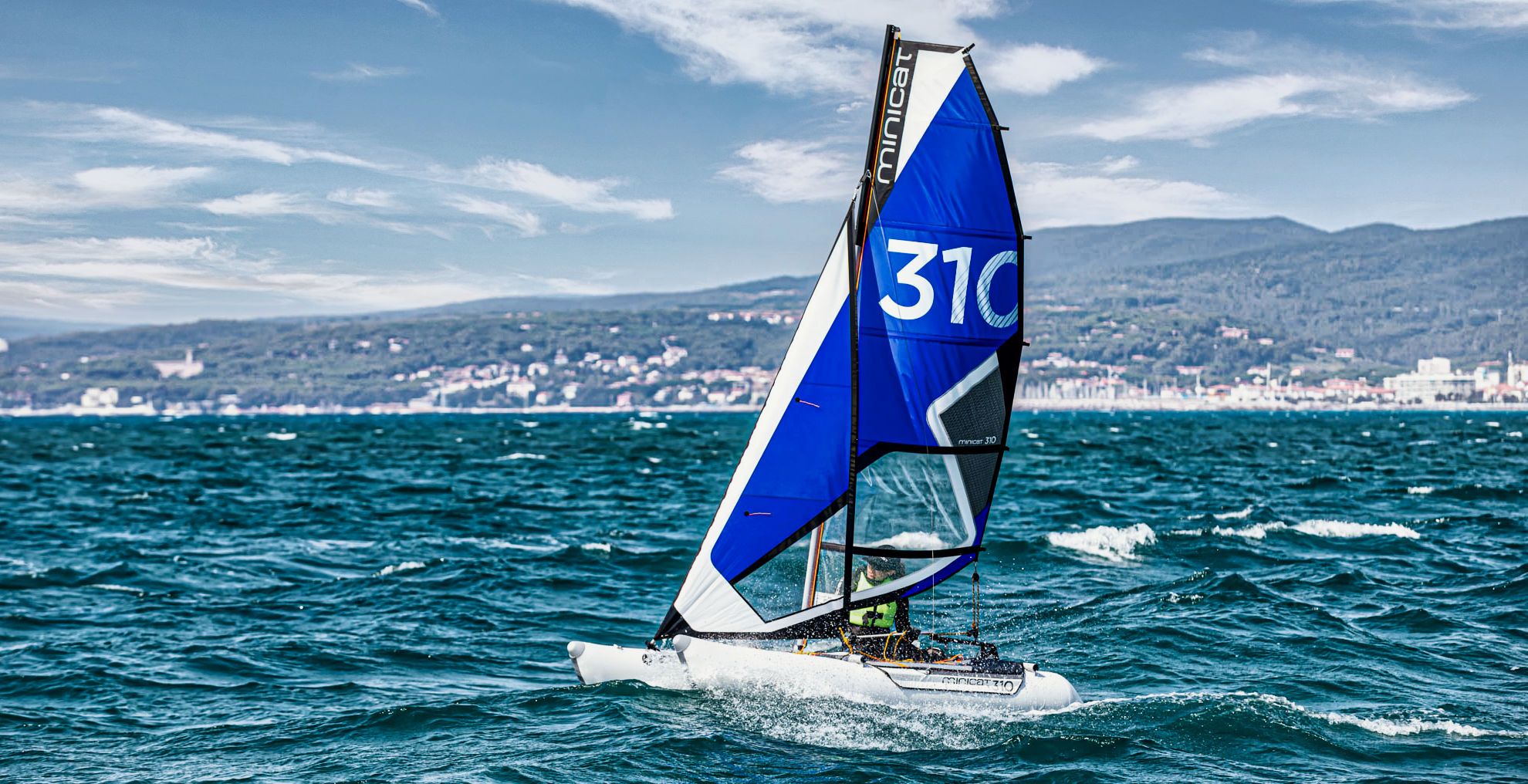
MINICAT 310
INFLATABLE SAILBOAT
- 3-piece Aluminium Mast – grey & black powder coated
- Main Sail – 3.75 m2 (no boom)
- Jib – 1.50 m2
- Aluminium Rudder
- Grey Floats pre-fixed to the main frame for rapid assembly
- Black Main Trampoline fixed with special grab-handles
- Long Keel Fins – same fixing as with M420 models
- Super easy and fast assembly
- Fits in a single bag 1600x320x360 mm, highly portable
It is designed for individual sailors who like speed and performance or families seeking a compact and safe boat to have fun with. Ideal as a yacht accessory.
Due to the size and design of the M310, with floats pre-fixed to the main frame with a trampoline, the M310 Sport can be set up in only 15-20 minutes. At just 32.5kg, portability and performance are both optimized.

| length | 3100 mm |
| width | 1400 mm |
| height of the mast | 3800 mm |
| weight | 32,5 kg |
| diameter of floats | 390 mm |
| sail | main sail+jib |
| main sail | 3.75 m2 |
| jib | 1,5 m2 |
| trampoline | 1350×950 mm |
| dimensions of the bag | 1600x320x360 mm |
| design category | ‘D’ |
| carrying capacity | 235 kg |
| number of persons | 2 |
| time of assembly / dismantling | 20 min. |
FRAME & DECK
The MiniCat 310 frame, to which the floats attach, is produced from light-weight aluminium and the frame parts are powder coated. The trampoline is produced from high strength woven plastic fabric. The frame is attached to the floats by means of welded-on ‘flags’, which are inserted into the pockets on the floats. The design is such that these are pre-fixed to the main frame with trampoline so the assembly time is shortened to the minimum.
The central tube is attached to the underside of the frame and the rudder mechanism is housed at the rear of the tube. At the front of the tube is the anchor-point for the mast line and jib.
The MiniCat is equipped with two inflatable floats 3.15 m length and 39 cm diameter. The floats are made of reinforced Heytex 5509, highly resistant to abrasion and very hard wearing. This material is produced in Germany and production technology was adopted from the production of ‘white-water’ rafts. The floats are single-chamber with a combined load capacity of 240 kg.
To fully enjoy your sailing, you must confidently control your boat. It is imperative to minimize ‘side-sail’, especially when sailing against the wind. To achieve this keel fins were designed to attach under each float. Their design and shape give excellent performance yet still allows the boat to be sailed in very shallow water without the risk of damage.
The mast consists of three sections of equal length, slotted together. The length of the assembled mast is 3.8 m. The mast is from alloy tubing (AIMg 0.7 Si) powder coated grey and black and has a groove for the sail attachment. This construction ensures high rigidity and strength for ultimate safety, performance and enjoyment.
The MiniCat is equipped with a main sail and jib. The total area of the sails is 5.15 sqm (main sail 3.75 sqm, jib 1.40 sqm). The material ‘Dimension Polyant’ is used with a surface density of 175 g/m. The main sail is ‘all-spire’ construction, i.e. without a boom. There are 6 flat spires in the sail. MiniCat Sport is equipped with a ‘jib furler’. The main sail has a window to ensure better visibility while sailing.
The aluminium rudder on the MiniCat is attached to the central tube. The design of the rudder allows it to be raised at a 90-degree angle, so at the shore or in very shallow water there is no danger of damage. The rudder can be locked in both positions, raised or lowered.
The tiller arm is jointed allowing full 360-degree movement.
Fittings from the companies Ronstan, Seasure, Clamcleat and Suchomel are used throughout the MiniCat.
All spare parts and accessories are available. See our SPARE PARTS & ACCESSORIES CATALOGUE
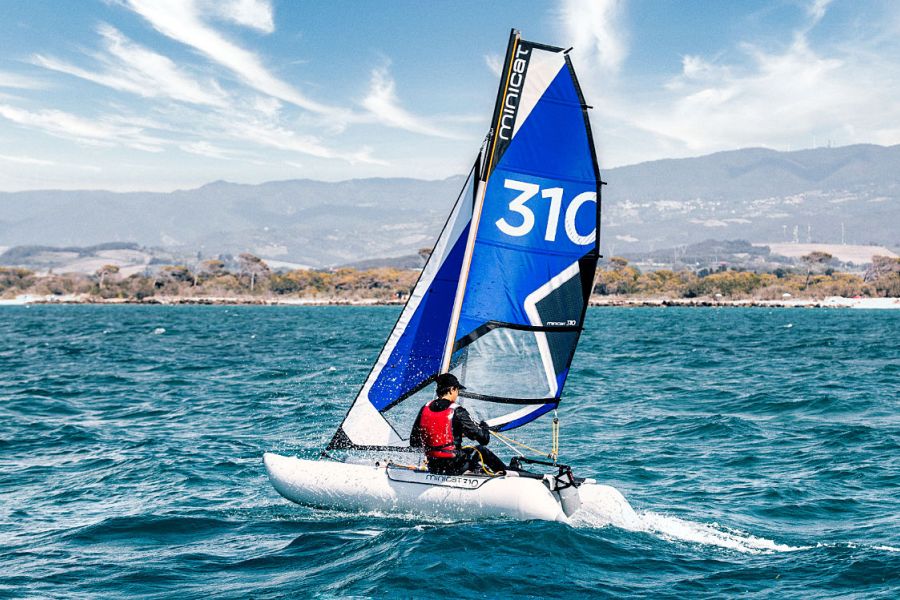
Click below to start
WhatsApp Chat is free
Save 10% on new Happy Cat Sailboats while supplies last Discount Code: EOYHAPPYCAT

MiniCat: Our Favorite Inflatable Sailboat Years Later
Apr 24, 2020
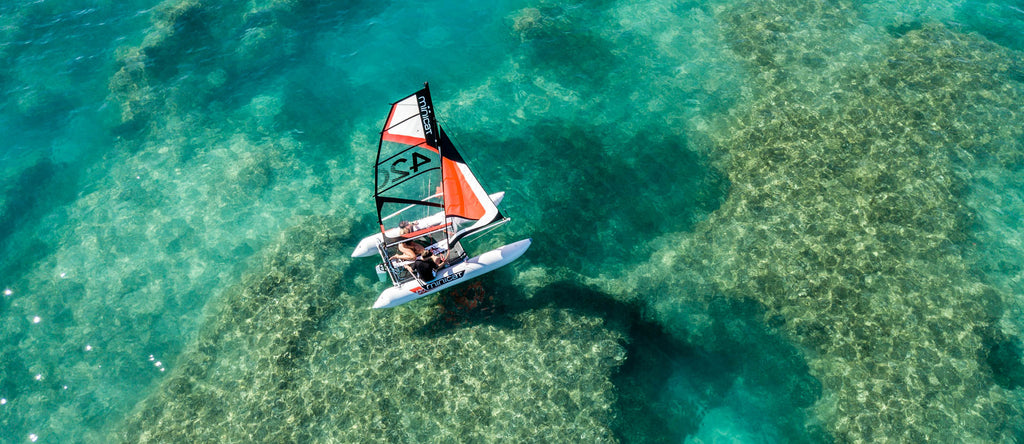
It’s been 8+ years since MiniCat came to the USA, and Red Beard Sailing couldn’t be prouder to be the East Coast Distributor for the world’s favorite portable sailboat. As you know, we specialize in inflatable sailboats, and we only carry the best in the business. The MiniCat does not disappoint.
Offering 4 sizes that are capable of crewing 1 to 4 people, MiniCats are also built to go anywhere. All models fit into 1 to 3 bags and can be assembled in 10 to 40 minutes, depending on the model. You can even remove the mast and add an outboard to transform these boats into a tender. To top it off, they also come with a 24-month warranty.
So what’s happened in the last 5 years?
- In 2018, MiniCat launched the MiniCat Guppy .
- In 2019, MiniCat gave a facelift to all of its models.
- In 2020, MiniCat launched an all-new 460 Elite model, with an ultra-light carbon fiber mast, rudder, and bowsprit.
- And Since 2015, Red Beard Sailing has sold over 100 MiniCats!
Before we dive into the MiniCat fleet, if you’re looking for a quick overview of what MiniCat has to offer, check out our brand new MiniCat Overview page. You can compare the entire fleet, view a variety of videos, and learn more about the MiniCat brand.
The 2020 MiniCat Inflatable Sailboat Lineup
MiniCat Guppy

Based off of the popular MiniCat 310, the Guppy is designed to be efficient and straightforward. A perfect boat for beginners, the Guppy assembles in just 10 minutes. Fitting in just one bag, you can transport the Guppy by car and even check it as luggage for a flight.
Starting at just $3,500, the Guppy provides value that is hard to beat at that price. A perfect toy for bringing along in your camper or a larger boat or yacht.
MiniCat 310

MiniCat’s first boat, now over 15 years old, is the MiniCat 310. Large enough for 2 people and assembling is just 25 minutes.
Say goodbye to your slip and trailer.
As is standard for all MiniCats, the 310 fits in a bag. Weighing only 77lbs, the 310 will fit in many cars and most SUVs with ease. A compact boat that is built for performance, it’s no wonder that the MiniCat 310 is such a popular boat.
The MiniCat 310 is offered in 2 different trim levels. Super, and Sport.
- Super is the base model boat and is great for beginners or kids. This boat is rated for 2 people.
- Sport is similar to the Super and introduces a roller furler for the jib. This is the one we recommend.
“Since the first time I saw a MiniCat being sailed (circa 2009), I was so impressed at how so much fun could be had from a sailing boat that you could carry in a bag.”
- Laura Dekker, Youngest Sailor to solo-circumnavigate the world
Shop MiniCat 310
MiniCat 420

The MiniCat 420 is Red Beard Sailing’s best selling boat! Are we surprised? Not at all.
The MiniCat 420 can crew up to 4 people and has a carrying capacity of 992lbs, making it large enough for the entire family without sacrificing on performance. The 420 is offered in 4 different trim levels: Instinct, Emotion, Evoque, and the Laura Dekker Edition.
- Instinct is the base model and is the only 420 model that does not have a boomed mainsail. A plus for parents in that no heads will get knocked by the boom. This boat has a lighter-weight mast for easier stepping than the Emotion and above.
- Emotion comes with a boomed mainsail and dedicated forestay, providing greater sail shape control.
- Evoque is a “carbon” copy of the Emotion, the difference being it uses carbon fiber instead of aluminum or fiberglass on the bowsprit, boom, and rudder
- Laura Dekker Edition is similar to the Evoque, but features a red, white, and blue sail design and a carbon fiber Poly-X racing mainsail!
Shop MiniCat 420
MiniCat 460

The largest boat in the MiniCat Fleet is the MiniCat 460. Measuring 15 feet in length, the 420 is impressively lightweight, coming in at 128lbs. Fitting into three bags, the MiniCat 460 maintains the MiniCat tradition being ultra-portable and built for performance.
If you’re looking for speed, we highly recommend the gennaker and snuffer add-on to this boat. Featuring a 129 ft² (12 m²) sail area, the performance increase is noticeable.
The 460 is offered in 2 different trim levels: the Esprit and the brand-new 460 Elite.
- Esprit offers an additional 20ft² of sail area compared to the MiniCat 420 and can carry an impressive 1,212lbs.
- Elite is the only MiniCat with a carbon fiber mast! The lightweight mast adds stability, speed, and more control. The mast is light enough to lift with one hand!
Shop MiniCat 460
MiniCat Assembly:
- 1 Storage & Transport Bag w/ Wheels
- Total Weight: 58 pounds
- 10 minute assembly time
- 1 Bag w/ Wheels (optional 2 smaller bags for single bag weight reduction)
- Bag Size: 1x 54" x 15" x 15" (77lbs) [Optional 2x 54" x 12" x 12" (38 lbs each)]
- Total Weight: 77 lbs
- 25 minute assembly time
- 2 Bags w/ Wheels
- Bag Size: 2x 68" x 12" x 12" (approximately 50 lbs each)
- Total Weight: 97 lbs
- 30 minute assembly time
- 3 Bags (2 with wheels)
- Bag Sizes: 2x 68" x 12" x 12" (50 lbs each) | 1x 39" x 12" x 12" (20 lbs)
- Total Weight: Esprit: 128 lbs | Elite 118 lbs
- 45 minute assembly time
Accessories
One of the best aspects of owning a MiniCat is the number of accessories that are available. You can really craft the sailing experience you’re looking for.
MiniCat doesn’t hold back with how you can customize your boat. Red Beard Sailing carries MiniCat:
- Outboard Mounts
- Front Trampolines
- Inflatable Seats
- Trolly Wheels
Shop Accessories
- MiniCat Overview
- Shop MiniCat Boats
- MiniCat Buyer's Guide
- Test Sails and Demos
- Compare Boats
Sign Up for Our Newsletter
Receive exclusive offers, and be the first to know about upcoming events, demos, sales, and discounts.

IMAGES
VIDEO
COMMENTS
MiniCat is the answer to the regular portability and storage issues associated with small sailboat ownership and sailing affordability. MiniCat allows all to sail: young (and not so young) beginners and experienced sailors, apartment dwellers, and superyacht owners. Packed in 1-3 bags, the MiniCat inflatable catamaran is easy to transport by ...
Red Beard Sailing is a premier distributor for XCAT, MiniCat, ROWonAIR, Happy Cat, Grabner, and Takacat. Independently owned, Red Beard Sailing is your one-stop-shop for mini catamaran, small catamaran boats, inflatable dinghies, sailing accessories, & more. (410) 705-5026 Please feel free to contact us, day or night. If we are up and awake we ...
Red Beard Sailing is a premier distributor for XCAT, MiniCat, ROWonAIR, Happy Cat, Grabner, and Takacat. Independently owned, Red Beard Sailing is your one-stop-shop for mini catamaran, small catamaran boats, inflatable dinghies, sailing accessories, & more. (410) 705-5026 Please feel free to contact us, day or night. If we are up and awake we ...
Main sail: 6.50 m² (70 ft²) "Dimension Polyant" Dacron. Jib sail: 3.20 m² (34.5 ft²) Dacron. Gennaker sail (optional): 10.5 m² (113.0 ft²) Jib furler: continuous line. Pontoons: 420 x 45 cm (13.8 x 1.5 ft) grey reinforced German-made Heytex 5509 reinforced PVC single-chamber with D-rings for optional front trampoline or anchor rode
The original MiniCat. Takes 30 minutes to assemble rather than 20, with weight split into 2 ~45lb bags rather than a single ~90lb bag. The only boat perfectly designed for domestic air travel. Fiberglass rudder. Separate frame/trampoline/pontoons. Included: 2 bags. $5,000.00 $5,270.00. Color: Add To Cart.
Red Beard Sailing is a premier distributor for XCAT, MiniCat, ROWonAIR, Happy Cat, Grabner, and Takacat. Independently owned, Red Beard Sailing is your one-stop-shop for mini catamaran, small catamaran boats, inflatable dinghies, sailing accessories, & more. (410) 705-5026 Please feel free to contact us, day or night. If we are up and awake we ...
The MiniCat inflatable portable catamaran sailboat collapses down into duffel bags that you can take with you anywhere; no truck, trailer, nor slip needed. Assembly time is not much more than rigging a traditional boat, yet it offers a unique sailing experience, with acceleration only an ultralight can offer. No wonder it's the world's ...
MINICAT 420. MiniCat 420 is the most popular small inflatable catamaran sailboat from the MiniCat range, offering a great choice of models for all sailing skill levels. From the simple M420 Instinct with Dacron sails and no boom to the funky black carbon version M420 Evoque with monofilm transparent sail equipped with all the small benefits you ...
This construction ensures high rigidity and strength for ultimate safety, performance and enjoyment. SAIL. The MiniCat 420 is equipped with a main sail and a jib. The total area of the sails is 9.7 sqm (main sail 6.5 sqm, jib 3.2 sqm). The material 'Dimension Polyant' is used with a surface density of 175 - 240 g/m.
GUPPY is an inflatable catamaran you can take on the plane with you when going on a sailing holidays, is easy to fit in any campervan, motorhome or RV, even a family car and is a great addition to your super-yacht or live-aboard without the usual storage and assembly problems. Super easy and fast assembly - 10 mins only - no tools required.
Deck: 190 x 145 cm (6.2 x 4.8 ft) woven plastic trampoline affixed to powder-coated aluminum frame. Keel: UV-stabilized polypropylene low aspect ratio fins. Fittings: Hardware by Ronstan, Seasure, Clamcleat, and Suchomel. Assembled dimensions: 460 x 220 x 659 cm (15.1 x 7.2 x 21.6 ft) Bag dimensions: Two 175 x 30 x 30 cm (5.7 x 1 x 1 ft) and.
All models fit comfortably in any personal car. It has never been easier to take your boat anywhere with you, without the worry of towing a trailer. Heading to the beach, river or lake? If you have a question about our products please get in touch here. Minicat is the portable and fun sailing solution!!
Red Beard Sailing is a premier distributor for XCAT, MiniCat, ROWonAIR, Happy Cat, Grabner, and Takacat. Independently owned, Red Beard Sailing is your one-stop-shop for mini catamaran, small catamaran boats, inflatable dinghies, sailing accessories, & more. (410) 705-5026 Please feel free to contact us, day or night. If we are up and awake we ...
With excellent sailing characteristics and simple control, the MiniCat portable catamaran is the best small sailboat for young sailors and beginners. It also strongly appeals to older, experienced sailors. Despite MiniCat's ultra-light weight and simplicity, major emphasis has been given to the high quality and strength of the materials used ...
The point of sail defines the direction of the wind relative to your cat. With the right point of sail, you will be in a position to sail your catamaran smoothly. The point of sail differs depending on the angle of your cat from the wind. The different points of sail include: Running: In a running point of sail, the wind blows behind your back ...
Doesn't Mata is a superb example of the popular, Australian built Tasman C43 catamaran. She is ready for new owners to set off and enjoy great cruising adventures. Step on board from the large transoms up gradual stairs and you'll find a huge aft cockpit area for this size of vessel all under the cover of a rigid Hardtop.
1. Pizza, Diner. Shustov. 14. $$ - $$$ • Russian. Frequently Asked Questions about Chernogolovka. What are the best places to eat in Chernogolovka? What is Chernogolovka known for? Chernogolovka Tourism: Tripadvisor has 251 reviews of Chernogolovka Hotels, Attractions, and Restaurants making it your best Chernogolovka resource.
Red Beard Sailing is a premier distributor for XCAT, MiniCat, ROWonAIR, Happy Cat, Grabner, and Takacat. Independently owned, Red Beard Sailing is your one-stop-shop for mini catamaran, small catamaran boats, inflatable dinghies, sailing accessories, & more. (410) 705-5026 Please feel free to contact us, day or night. If we are up and awake we ...
Chernogolovka is a town in Moscow Oblast, Russia. Center of the town is located some 43 km northeast of the Moscow city limit and 59 km from Red Square. Its population in 2018 was 21,342. Photo: A.Savin, CC BY-SA 3.0. Photo: Svetlov Artem, CC BY 3.0. Ukraine is facing shortages in its brave fight to survive.
The Guppy is the smallest sailboat in the MiniCat lineup, but quickest to assemble. While there's a performance trade-off compared to its bigger siblings, it still provides plenty of fun on the water considering that it fits in a single bag weighing under 60 lbs. It's the the entry-level sailboat for the novice sailor or the take anywhere boat ...
MINICAT 310. 3-piece Aluminium Mast - grey & black powder coated. Main Sail - 3.75 m2 (no boom) Jib - 1.50 m2. Aluminium Rudder. Grey Floats pre-fixed to the main frame for rapid assembly. Black Main Trampoline fixed with special grab-handles. Long Keel Fins - same fixing as with M420 models.
Red Beard Sailing is a premier distributor for XCAT, MiniCat, ROWonAIR, Happy Cat, Grabner, and Takacat. Independently owned, Red Beard Sailing is your one-stop-shop for mini catamaran, small catamaran boats, inflatable dinghies, sailing accessories, & more. (410) 705-5026 Please feel free to contact us, day or night. If we are up and awake we ...
Top Things to Do in Krasnogorsk, Russia: See Tripadvisor's 2,993 traveller reviews and photos of Krasnogorsk tourist attractions. Find what to do today, this weekend, or in July. We have reviews of the best places to see in Krasnogorsk. Visit top-rated & must-see attractions.
4. Church of St. John the Baptist. 5. Horse Riding and Sports Club Ivanovskoe. Impressive horses, excellent facilities, top trainers and coaches. Quite cheap, too - all in all, if you are into... Things to Do in Chernogolovka, Russia: See Tripadvisor's 251 traveler reviews and photos of Chernogolovka tourist attractions.